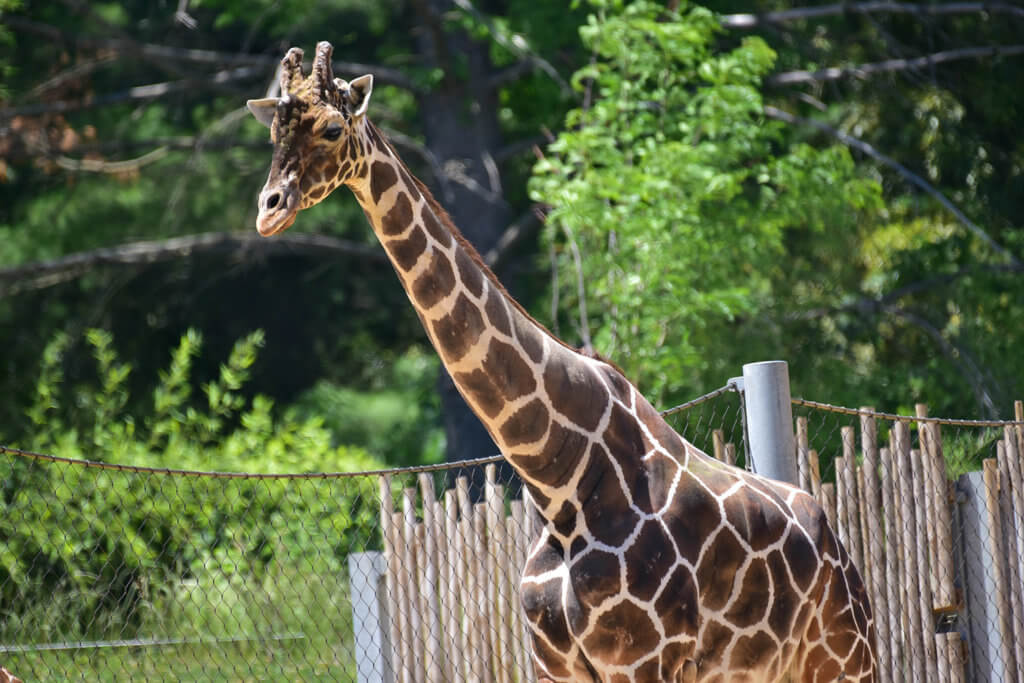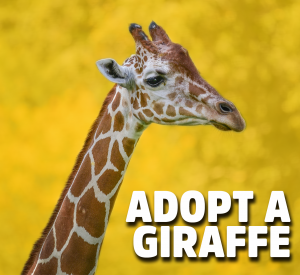Overview
“Where I live”
Giraffes live in eastern, central and southern Africa. They range across savannah, grasslands, and open woods in search of trees – especially their favorite, acacias – to feed upon.
The Maryland Zoo has several reticulated giraffes, one of nine recognized subspecies of giraffe.
“How I live there”
Giraffes travel in loose, informal herds and are not territorial. They roam freely in search of food. For the most part, life in a giraffe herd is calm. Bulls will spar to establish dominance but then will continue to graze side by side. The dominant male feels no need to drive other males from the herd.
Giraffes spend most of their time feeding. Their extraordinary height allows them to browse on leaves that other grazing herbivores can’t reach. Giraffes curl their long, black tongues around leaves or new shoots in the upper branches of trees and pull them into their mouths. They prefer the thorny acacia tree to any other plant. They also browse on leaves closer to the ground and may also eat fruit and even soil that is rich in minerals. A giraffe can eat well over 100 pounds of food per day.
Giraffes can go several days without water but must eventually drink to satisfy their thirst. Adults are most vulnerable when drinking because of the awkward stance they must take: legs spread wide and head lowered to the ground.
Like many large land mammals, giraffes doze more than sleep. Deep sleep is brief (and dangerous, because of vulnerability to predators). While young giraffes lie down periodically throughout the day, adults rarely do. They rest while standing; they may lie down after dark, but only briefly.
“Making my mark”
When giraffes stand together on open land, they are hard to miss. They make an impression. That being said, they do not significantly alter the environment in a way that affects other animals, despite their size and constant need to feed. They graze mainly on the highest leaves and branches, leaving those lower down for other animals.
“What eats me”
Lions, leopards, hyenas and wild dogs may try to prey on giraffes but it’s no easy task. Despite their gentle tendencies, adult giraffes are formidable foes and can inflict serious injury on any predator, including lions, with blows from their front hooves. According to data for giraffes of the Serengeti, the mortality rate for adults is very low – around 3% — while for more vulnerable baby giraffes, aged six months or less, the mortality rate is almost 50%.
Raising Young
After a gestation period of 15 months, a female giraffe gives birth usually to a single offspring. Twins are extremely rare. When born, a baby giraffe drops about six feet to the ground – a rude awakening by any standards! The newborn attempts to stand within a few minutes but may need to keep trying for an hour or more. Once standing, a newborn giraffe immediately starts walking and seeks out its mother. It will begin to eat solid food in just a few weeks but will continue to nurse for 15 to 17 months. To survive, baby giraffes require the protection of their herd.
Conservation
A species-wide assessment of giraffes has resulted in a “vulnerable” listing by the IUCN, the world’s leading conservation organization, with the caveat that “populations of giraffes are scattered and fragmented, with different growth trajectories and threats.” Currently, of the nine subspecies, four are increasing, four are decreasing, and one is stable. Reticulated giraffes are one of the subspecies suffering population decline. Giraffes are threatened primarily by habitat loss and degradation and illegal hunting and poaching.
Taxonomy
- Kingdom: Animalia
- Phylum: Chordata
- Subphylum: Vertebrata
- Class: Mammalia
- Order: Artiodactyla
- Family: Giraffidae
- Genera: Giraffa
- Species: camelopardalis reticulata



